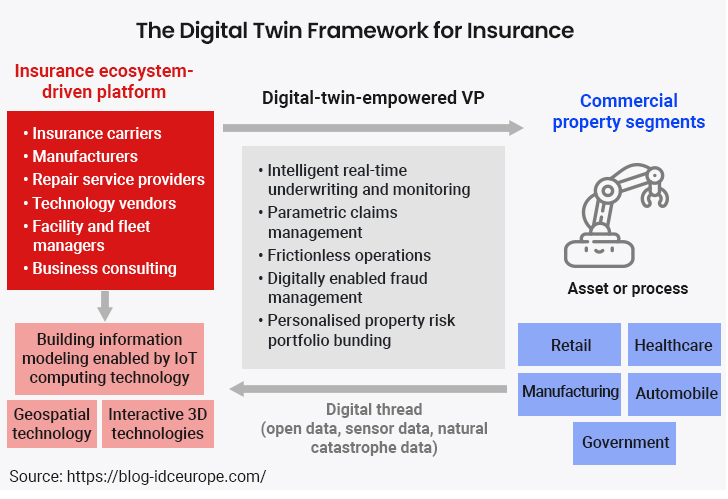As we fast approach 2025, the insurance industry is undergoing significant changes. Customer expectations are rising, technology is advancing rapidly, and regulatory laws are continuously changing, and as a result traditional operations are being impacted completely.
Leading Analyst firms predict that technology budgets in the insurance sector will grow by 8% in 2025. Insurers will utilize advanced analytics and AI to refine customer experiences, optimize claims management, and tighten processes.
Based on insights from leading analysts and industry players, this blog explores the technology trends set to redefine how insurance CIOs and leaders are going to operate in 2025. From integrating digital twins to voice-activated tools, leveraging AI for real-time customer insights, these trends will shape the next chapter of the insurance landscape.
1. Digital Twins Revamping Risk Assessment
Digital twins—virtual replicas of physical assets—are no longer going to be futuristic concepts but operational tools transforming risk management.
Digital twins create real-time models of insured assets, offering predictive insights. For example, insurers will be able to detect potential risks in a property’s structural integrity before damage occurs.
In Claims Management, these replicas will allow for virtual inspections during claims processing, saving time and costs.
Digital twins significantly enhance underwriting for parametric insurance products. By using AI and satellite image analysis, insurers can detect potential loss events in a commercial property portfolio, verify coverage, and potentially automate claim settlements through straight-through processing.
For fraud management, digital twins utilize continuous IoT data streams to recreate the damage environment post-claim, helping insurers assess the legitimacy of claims.
Implications: By reducing physical site visits and leveraging predictive analytics and IoT data, insurers will be able to achieve significant cost savings while enhancing customer trust through proactive solutions.
Harness New-Age Technology Trends to Drive Growth
2. API-Driven Ecosystems Enabling Friction-Free Collaboration
The rise of insurance software platforms leveraging APIs has ushered in an era of collaboration beyond traditional silos. Insurers will now be able to easily connect with digital platforms in industries such as automotive, healthcare, and real estate.
API- or microservices based architecture will enable insurers to bundle diverse services, like integrating real-time diagnostics in auto policies or health monitoring for life insurance products. For instance, through a single app, insurers will be able to easily manage vehicle diagnostics, insurance claims, and home security.
Implications: APIs drive customer-centric innovations, opening new revenue streams and delivering convenience that meets modern expectations.
3. Voice-Activated Insurance Technology for Enhanced Accessibility
Voice technology is poised to simplify how customers interact with their insurers. Powered by AI, these systems are quickly going to become an essential part of technology toolkits.
Customers can now modify policies, check claim statuses, or renew coverage using voice commands. For insurers, it reduces customer service workloads and enhances response times. For example, companies using voice-powered chatbots are expected to report significant reduction in call-center queries.
Implications: With voice technology, insurers will be able to cater to the tech-savvy demographics seeking fast, seamless solutions, ultimately boosting customer loyalty.
4. IoT and Telematics for Proactive Risk Management
IoT devices and telematics are expected to shift the insurance practice from reactive to proactive. The global usage-based insurance market is projected to grow from USD 30.6 billion in 2023 to USD 80.7 billion by 2028, at a 21.4% CAGR. Key factors driving this growth include lower premiums compared to traditional automotive insurance, government mandates for telematic devices, increased sales of connected cars, and more on-road vehicles.
- Auto Insurance
Telematics devices will monitor driving habits and offer custom premiums for responsible drivers. - Property Insurance
Smart home devices will alert homeowners and insurers about risks like water leaks. - Health Insurance
Wearables will encourage healthier lifestyles with rewards for meeting fitness goals.
Implications: Insurers using IoT solutions can reduce claim occurrences, improve policyholder engagement, and develop sustainable risk models.
5. Drones and Robotics for Inspections
Drones and robotics are becoming essential for aerial inspections, especially in challenging environments. They are now commonly used to survey properties, providing detailed imagery and data for better risk assessment and underwriting.
I. Risk Assessment and Underwriting
Drones are now rapidly being used to survey properties, offering detailed imagery and data for better risk evaluation. This method allows insurers to assess difficult-to-reach areas without risking human inspectors, leading to more accurate underwriting and fairer policy pricing. They will allow insurance workers to inspect dangerous areas without physical risk, improving workplace safety.
II. Cost Reduction
Replacing manual inspections with drones, especially in hazardous or hard-to-reach locations, can greatly reduce costs. Deloitte estimates this could save the insurance industry nearly $7 billion annually.
III. Claims Processing
Post-disaster or accident, drones can quickly assess damage, providing insurers with rapid and comprehensive visual data. This speeds up claims processing, enabling faster payouts and better customer satisfaction. For example, Allstate uses drones to cut repair estimate times to just 4.5 days.
IV. Fraud Detection
Drones capture detailed images and data that potentially help insurers identify fraudulent claims by comparing accurate before-and-after property images, checking the extent and cause of damage.
Implications: These tools reduce operational risks, cut inspection costs, and improve the speed and accuracy of claims processing.
Embracing Technology Trends in Insurance
Adopting these technology trends offers numerous advantages, including:
- Increased Efficiency
Automation reduces manual interventions, allowing teams to focus on strategic tasks. - Improved Customer Satisfaction
Faster service and personalized experiences enhance loyalty. - Cost Optimization
Tools like drones and AI minimize operational costs. - Proactive Risk Management
IoT and digital twins prevent claims by addressing risks early. - Expanded Market Reach
API-driven ecosystems enable diversified offerings and new revenue streams.
Quick Look at Few Barriers to Technology Adoption in Insurance Space
While promising, implementing these technologies comes with hurdles:
- Data Privacy Concerns
Ensure robust compliance with regulations like GDPR and CCPA. - Integration Complexities
Invest in cloud-native solutions to simplify integration. - Skill Gaps
Upskill teams through targeted training on emerging technologies. - Cost Constraints
Begin with pilot projects to demonstrate ROI before scaling.
By tackling these challenges strategically, insurers can fully unlock the potential of emerging technology trends.
Summing Up
The technology trends impacting the year 2025 are not mere shiny innovations but a definite shift in the insurance industry’s approach to delivering lasting value. For insurance CIOs, this is an opportunity to not only embrace these trends but to excel at them, transforming operations, enhancing customer relationships, and driving measurable growth. By adopting a forward-thinking approach to new technologies, insurers can stay relevant and achieve profitable growth in a competitive market. The future of insurance goes beyond managing risks—it’s about developing solutions that meet the evolving needs of the masses.







